The exhibition Flesh and Blood is not for the faint-hearted. Curated by Raphi Etgar, the founder and director of this socio-political Museum, it brings together works by 28 artists from Israel, Europe and the US that focus on Man’s harsh treatment of animals. The result is an exceptionally high quality show, but one that certainly has the potential to distress the viewer.
A wall text set alongside Aquarium, a series of shadowy paintings by Etgar of fish, explains that his ‘curatorial journey” towards this particular exhibition began long ago while visiting a village in the Swiss Alps. There, he has never forgotten seeing an abandoned aquarium where a solitary fish, imprisoned in a tank barely fitting its body, was twisting and gasping for survival.
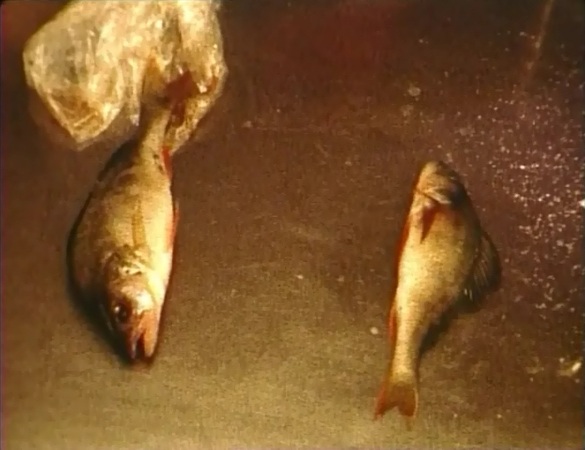
The fate of fishes is the subject of Kalakeittos, a video piece by Pia Marie Martin (Germany). In her films she employs stop-animation, a technique whereby physically manipulated objects appear to move on their own. In this brilliant example, set in a gloomily lit kitchen, two fish jump unaided out of a paper bag, shed their own skins before sliding into a cooking pot. Tchaikovsky’s Swan Lake is heard in the background, majestic music contrasting with the inevitable, seemingly carefree progress of the fish towards their death.
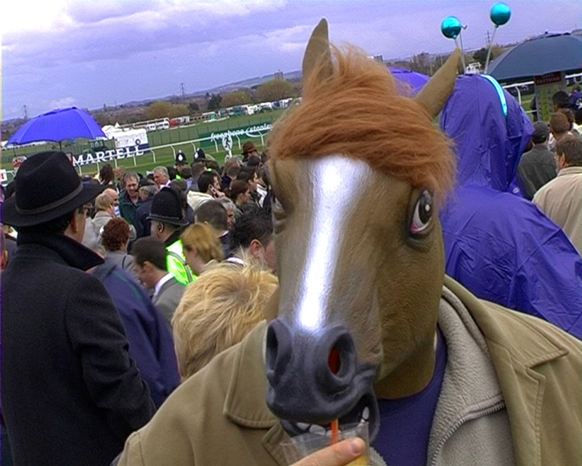
Aquariums- or fish prisons – are designated for the pleasure of humans. Horse-racing also, where the animals are pushed beyond their strength and regularly sustain horrific injuries. This is the subject of an impressive video work by Yael Bartana (Israel/Netherlands), an artist whose video work has consistently focused on social rituals. Taking her camera to England, to the Aintree racecourse, on the day when the famous Grand National steeplechase was being held, she exposes the vulgarity of the occasion; a chance to meet one’s friends, show off a glamorous hat; quaff a beer or two. . Spotted in the crowd (does anyone notice or care?) is a man wearing the mask of a horse. The race itself is not shown, only the thundering of hooves. While a brief glimpse of the heads of two horses, supplies the only noble moment in the film.
By coincidence the current screening of this video coincides with the news that two horses died last month in the 2013 Grand National – and four last year.
The Animal Film by Victor Shonfeld and Myriam Alaux (England) is probably one of the most influential works every made promoting Animal Rights. When it was first shown in 1981 it attracted world-wide attention. Excerpts from this film, shown in this exhibition, document horrific examples of the misuse and abuse of animals. This is not a detailing of random abuse, but a record of systematic acts of cruelty by, among others, factory farmers, drug firms, scientists, and so called ‘sportsmen’.
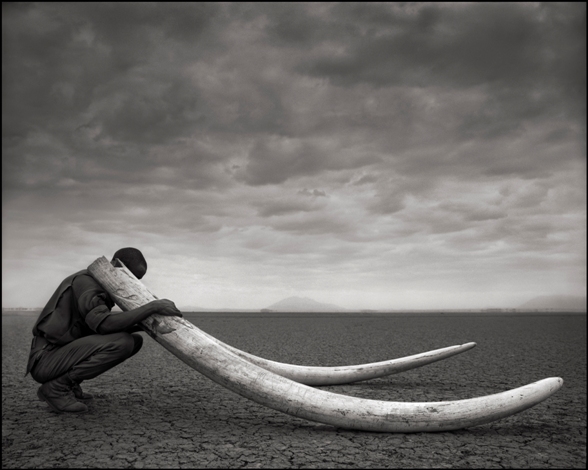
The hunting down and progressive annihilation of animals is a subject dealt with by many other artists. Among them Nick Brandt (USA,) who has specialized in memorializing animal life in Africa before it is completely wiped out by man. To achieve some stunning effects, which also illustrate the beauty and drama of the African landscape, he employs medium-format black and white film (without utilizing zoom or telephoto lenses as is customary in wild life photography.) Featured in one of his photos is the abandoned egg of an ostrich; in another- a poignant scene snapped in Kenya’s Amboseli Park- a ranger kneels to grasp the tusks of a dead elephant as if paying homage to its memory.
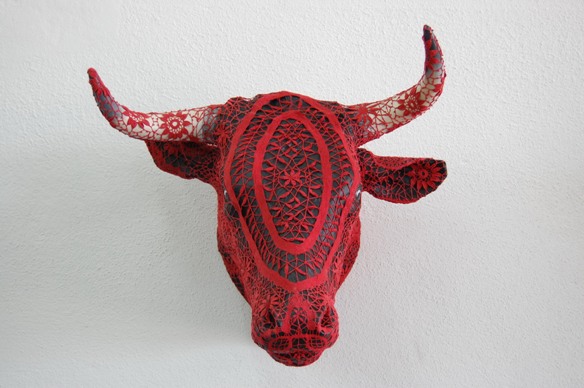
Bullfighting is a a topic explored by Joana Vasconcelos (Portugal). Taking a head of a bull sculpted by Rafael Bordalo Pinheiro (1846-1905), she has encased it in cotton and lace. This pretty ‘feminine’ addition might be viewed as softening the horror of this sport, save for the fact that the color chosen for this decorative mask by the artist is blood-red. Bulls are images also employed by Maria Cristina Piffer (Argentina). In her case, her artwork makes reference to the enormous number of animals slaughtered in her country to meet the demands of the meat industry. She shows two large digital prints of her home currency, the 20 pesos bill, replacing portraits of heroes of the past, with the head of a bull.
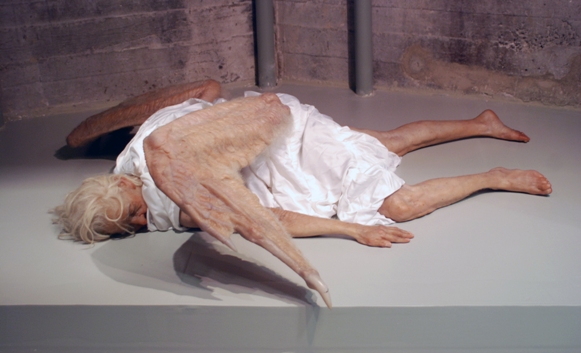
Su Yuan and Peng Yu, two of China’s most controversial artists, criticized in the past for public acts of violence against animals, and for the display of body parts, are represented here by a gentle, almost mystical piece. Titled Angel, it displays the life-size body of an elderly man lying on the floor. This figure is so realistically fashioned that one is tempted to kneel down check whether he is breathing or not. Attached to the prone figure are huge chicken-like wings terminating in claws. . Within the context of what this exhibition has successfully revealed, this fallen angel may well represent the flawed relationship between man and beast.
These are some of the highlights in an exhibition in which all the works make a powerful statement, yet most of them still stand strong and true as genuine works of art. The illustrated catalog produced for the occasion is especially impressive containing important essays referencing subjects featured in this show.
Also participating are: Martin Skauen (Germany-Norway),Doris Bloom (Denmark), Karin Kneffel (Germany), Joseph Semah(Netherlands), Allora and Calzadilla (Puerto Rico), Bill Viola, Harry Dodge, Haim Steinbach, Martha Friedman, Samuel Messer (USA), Hermann Nitsch (Austria), Sigalit Landau, Eden Auerbach Ofrat, Eran Gilat, Haran Mendel, Guy Zagursky, Shirley Factor and Anan Tzuckerman (Israel).
Museum on the Seam, 4 Chel Handasa St. Jerusalem (the Light Rail stops outside). Phone: 02 -6281278





